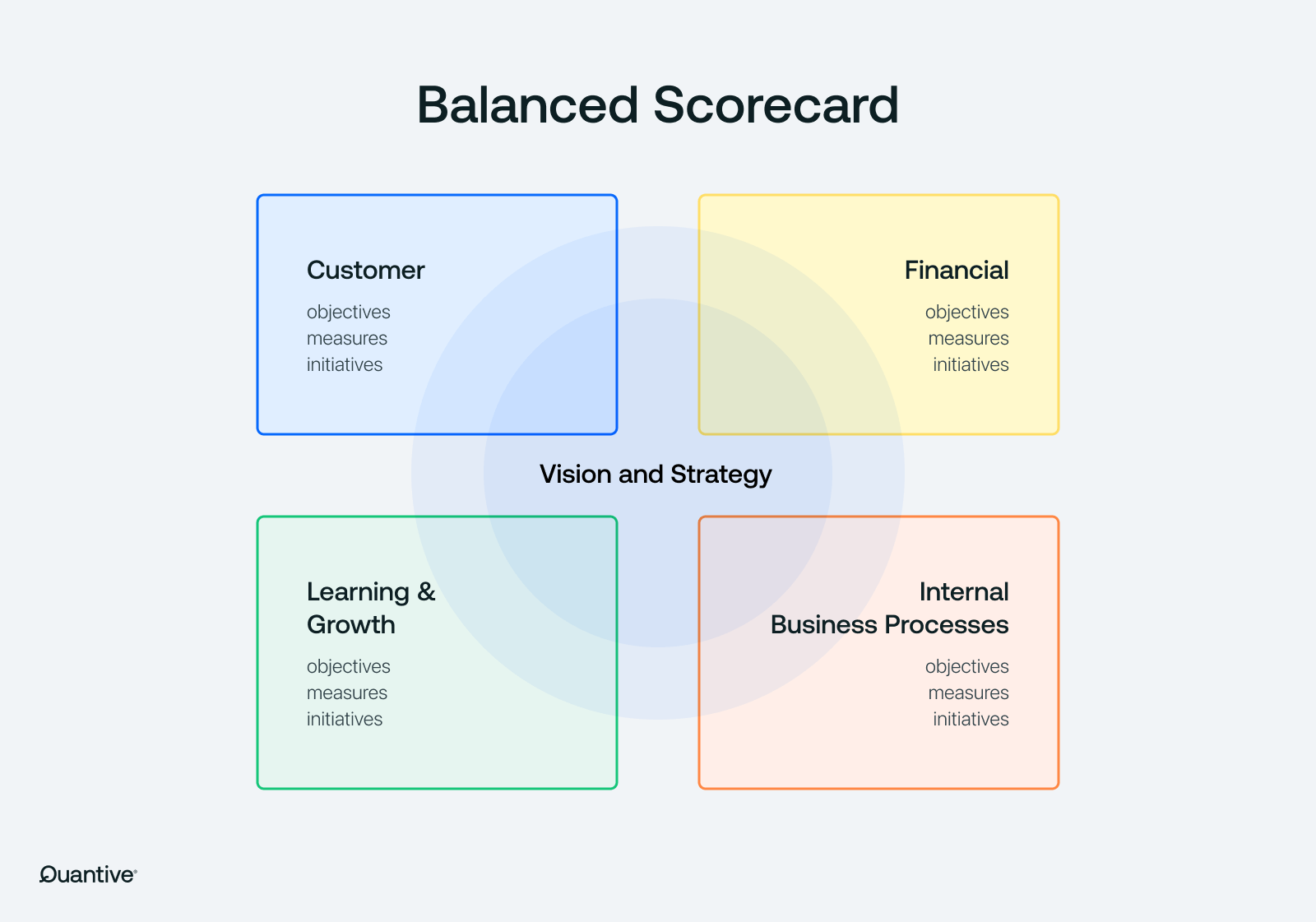Quantive is now part of WorkBoard. Get to know WorkBoard:
Ensuring strategic success often hinges on a well-structured framework. The Balanced Scorecard (BSC) facilitates this by converting your business strategy into actionable objectives and measurable goals, fostering alignment and focus across all organizational levels.
This article will give you the ins and outs of the Balanced Scorecard, covering its:
- Definition
- Elements
- Origins
- Use cases
- Benefits
- Examples
What is a Balanced Scorecard (BSC)?
The Balanced Scorecard is a strategic framework that comprehensively views a business's performance by looking at financial, customer, internal processes, and learning & growth perspectives.
This balanced approach ensures that all aspects of the business are considered, promoting a holistic view of organizational performance and strategic alignment.
What are the four components of the Balanced Scorecard Model?
The Balanced Scorecard outlines four critical perspectives organizations can use to track and measure performance, including a financial perspective, a customer perspective, an internal processes perspective, and a learning and growth perspective. These perspectives help businesses translate their strategic goals into actionable objectives and metrics.

Let’s dive deeper into the four perspectives of the Balanced Scorecard:
- Financial Perspective: Measures financial performance and shareholder value (e.g., profitability, revenue growth)
- Customer Perspective: Tracks customer satisfaction and loyalty (e.g., customer acquisition, market share)
- Internal Processes Perspective: Focuses on operational efficiency and effectiveness (e.g., product quality, innovation)
- Learning & Growth Perspective: Analyzes employee capabilities and potential for future growth (e.g., employee skills development, innovation initiatives)
Within each perspective, Balanced Scorecards employ three key components—Objectives, Measures, and Initiatives—that are essential for translating strategy into actionable plans and measurable outcomes:
- Objectives: Specific, measurable goals within each perspective that align with the overall strategy
- Measures: Metrics used to track progress towards achieving objectives
- Initiatives: Actionable steps taken to achieve objectives
Who developed the Balanced Scorecard?
Robert Kaplan and David Norton developed the Balanced Scorecard approach in the early 1990s. Kaplan, a Harvard Business School professor, and Norton, a business consultant, introduced this framework in their 1992 Harvard Business Review article "The Balanced Scorecard—Measures that Drive Performance." Their goal was to enhance traditional financial performance measures by incorporating perspectives on Financial, Customer, Internal Processes, and Learning & Growth, providing a holistic view of organizational performance and facilitating better strategic alignment and execution.
When to use the Balanced Scorecard?
A Balanced Scorecard is beneficial if you’re a business looking to:
- Translate strategy into action: If your business needs to break down broad strategic goals into actionable objectives and metrics, the Balanced Scorecard provides a clear framework for this translation
- Improve communication and alignment: When fostering a shared understanding of strategic priorities across all business levels is crucial, the Balanced Scorecard keeps everyone aligned toward joint goals
- Monitor performance across various areas: If your business needs to go beyond financial metrics to track progress, the Balanced Scorecard offers a balanced approach to performance measurement
- Drive continuous improvement: If you’re aiming to identify areas for improvement and adjust strategies as needed, the Balanced Scorecard supports ongoing evaluation and refinement of strategic initiatives
What is an example of using a Balanced Scorecard?
Let's look at an example of how a Balanced Scorecard strategy could work. Suppose a leading car manufacturer like Toyota, renowned for its hybrid cars, wants to regain ground in the pure electric vehicle (EV) market. Their current EVs might need to improve in distribution networks, overall sales, and customer perception compared to competitors.
The Balanced Scorecard can help Toyota navigate this challenge by focusing on four key perspectives and their respective three components:
- Financial: Increase EV market share and improve the profitability of the EV segment
- Measures: Track metrics such as market share percentage, EV sales revenue, and profit margins
- Initiatives: Implement cost reduction strategies in EV production, optimize pricing models, and increase investment in EV marketing campaigns
- Customer: Enhance customer satisfaction with EV models and increase customer awareness of EV offerings
- Measures: Monitor customer satisfaction scores, Net Promoter Scores (NPS), and brand awareness levels
- Initiatives: Launch targeted marketing campaigns highlighting EV benefits, enhance customer service training focused on EVs, and develop loyalty programs for EV customers
- Internal processes: Optimize EV production and distribution networks and improve the quality and charging range of EVs
- Measures: Track production efficiency, defect rates, and charging range improvements
- Initiatives: Invest in advanced manufacturing technologies, streamline supply chain processes, and establish partnerships with charging infrastructure providers
- Learning and growth: Develop employee expertise in EV technology and foster a culture of innovation in the EV space
- Measures: Monitor employee training hours, innovation project outputs, and employee engagement scores
- Initiatives: Implement comprehensive training programs on EV technologies, create innovation labs to encourage new ideas, and establish a rewards system for innovative contributions
How to use the Balanced Scorecard in your organization?
You can use the Balanced Scorecard system effectively by defining strategic objectives, developing KPIs, establishing targets & initiatives, aligning resources and capabilities, & monitoring & reviewing performance. Let's look at each of these steps in more detail.
Step 1: Define your strategic objectives
Clearly articulate your strategic objectives across the four Balanced Scorecard perspectives: Financial, Customer, Internal Processes, and Learning & Growth. These objectives should align with your overall business strategy and long-term vision.
Step 2: Develop your KPIs
Next, identify the key performance indicators (KPIs) to help measure progress toward your strategic objectives across the four perspectives. These KPIs should be specific, measurable, achievable, relevant, and time-bound (SMART).
Step 3: Establish targets and initiatives
Set clear performance targets for each KPI and develop initiatives to achieve these targets. Initiatives are the specific projects or actions that will drive performance improvements.
Step 4: Align resources and capabilities
Ensure your organization's resources and capabilities align with the strategic objectives and initiatives. This involves allocating budget, personnel, and other resources to support the initiatives.
Step 5: Monitor and Review Performance
Track and review performance regularly against the established KPIs and targets. Use performance data to make informed decisions and adjust strategies as needed.
What are the benefits of using the Balanced Scorecard System?
The Balanced Scorecard offers numerous advantages for businesses seeking to enhance their strategic management and performance measurement. These benefits include:
- In-depth performance analysis: Provides a holistic framework for evaluating organizational performance, encompassing financial and non-financial metrics to ensure a balanced approach to strategic goals. This can give the management team a comprehensive view for evaluation.
- Enhanced strategic alignment: Facilitates alignment of departmental goals with overall business strategy during strategic planning, ensuring that all parts of the organization work towards common objectives, a common strategy map, and a common long-term vision
- Improved decision-making: By incorporating diverse perspectives, the Balanced Scorecard helps organizations make informed decisions that balance financial performance with customer satisfaction, internal processes, and growth opportunities
- Risk management: Helps identify and manage risks associated with strategic initiatives, enabling businesses to anticipate challenges and adjust strategies proactively
- Continuous improvement: Encourages ongoing evaluation and refinement of strategies, fostering a culture of continuous improvement and agility in response to market dynamics and internal changes
Bolster your Balanced Scorecard creation with Quantive StrategyAI
Quantive StrategyAI can help you leverage the balanced scorecard concept in your internal business processes by automating data analysis and providing real-time insights about your strategy map. You can rely on it to:
- Develop a comprehensive Balanced Scorecard aligned with your strategic priorities
- Track progress across all four perspectives with clear visualizations and data-driven insights
- Identify areas for improvement and adjust strategies based on real-time data
This lets you make informed strategic planning decisions quickly and confidently, giving you a competitive edge to help sustain your position in a market rife with rapid changes and become a strategy focused organization.
Quantive empowers modern organizations to turn their ambitions into reality through strategic agility. It's where strategy, teams, and data come together to drive effective decision-making, streamline execution, and maximize performance.
As your company navigates today’s competitive landscape, you need an Always-On Strategy to continuously bridge the gap between current and desired business outcomes. Quantive brings together the technology, expertise, and passion to transform your strategy and playbooks from a static formulation to a feedback-driven engine for growth.
Whether you’re a fast-growing scale-up, a mid-market business looking to conquer, or a large enterprise looking for innovation, Quantive keeps you ahead – every step of the way. For more information, visit www.quantive.com.





